(and prions and viroids)
- No metabolism
- Cannot reproduce (or do ANYTHING) on their own
- Viruses are "hijackers" that take over cells
- direct host cells to make copies of virus.
- host cell neglects its own needs (and often lyses itself under control of viral genes) and dies in the process
- Most viruses are exceedingly small!
- Protein coats often have geometric shapes
- Relatively few genes in viral genomes
- There are many types of viruses
- Virtually all types of organsisms are infected by some virus or another
- Normally there is great host specificity
- One example: Bacteriophage - a type of virus that infects certain bacteria:
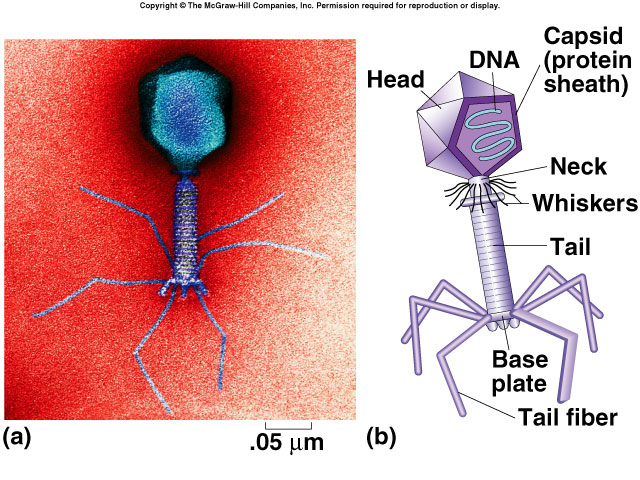
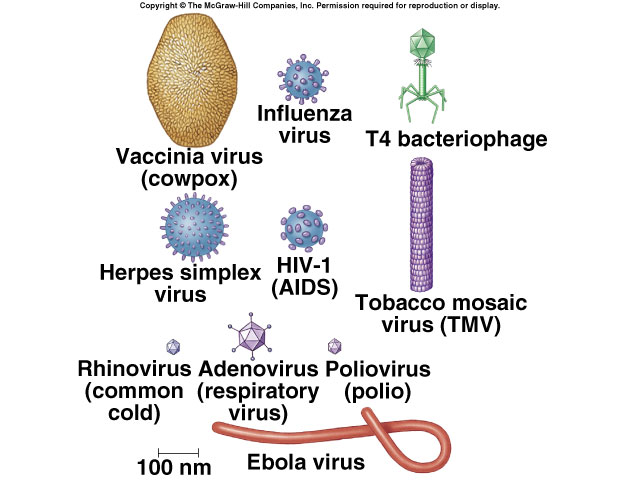
How big are viruses? See http://www.cellsalive.com/howbig.htm
(and for an even broader perspective on the sizes of things, see http://htwins.net/scale2/ )
3. Life cycle of a virus:
- Lytic cycle - taking over protein synthesis and nucleic acid replication machinery of cell to make new viruses.
- Cells break apart (are lysed) to release new viruses
- Lysogenic cycle - viral DNA is incorporated into host's chromosomes
- viral DNA is replicated along with host DNA
- may stay like this for long periods
- may enter lytic cycle at some point in the future.
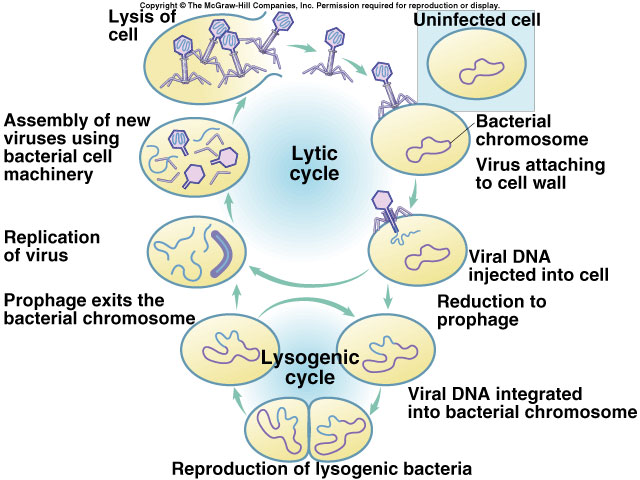
4. Recombination of viral DNA
- Can occur if more than one virus infect the same cell at same time
- Can produce new strains that are sometimes more virulent
- Influenza viruses
- many new strains arise when genetic recombination occurs between bird and human strains in pigs
- ducks and pigs are commonly raised adjacent to each other in Asia
5. Many common diseases and very serious human diseases are caused by viruses
- Colds
- Influenza (Flu)
- Human Immunodeficiency Virus - HIV
- Herpes
- Chicken pox/shingles
- Ebola
Antibiotics do not cure viral diseases! (though may help with secondary infections in some cases).
6. Prions and Viroids
- Prions - infectious protiens
- misfolded protiens that cause normally-folded proteins to mis-fold when the abnormal proteins come in contact with them.
- Scrapie, kuru, mad cow disease
- Viroids - infectious RNA
- cause of some common plant diseases
- e.g. Cadang-cadang disease of coconut palms, oil palms, and several other palms: https://en.wikipedia.org/wiki/Cadang-cadang
- Archaebacteria
- an ancient group
- live in many different habitats - some are very abundant in the sea - more than 20% of all the cells in the ocean!
- many (but not all) live in extreme environments
- hot springs, hydrothermal vents
- hypersaline habitats
- etc
- some types are VERY common and important in anaerobic aquatic sediments
- e.g. methanogens - use CO2 as terminal electron acceptors, produce methane as a byproduct of energy metabolism
- "fastidious anaerobes"
- humans frequently have methanogens living in colons
- (source of flammable gaseous emmisions!)
- Bacteria (or Eubacteria) - all of the other prokaryotes
- Tremendous diversity of species
- EXTREMELY ABUNDANT on Earth
- Many are EXTREMELY important to the functioning of the biosphere
- Most are free-living
- Some are photosynthetic and responsible for the majority of the oxygen in the atmosphere
- Many are heterotrophs
- diverse metabolisms
- Some are parasitic/disease-causing
2. Prokaryotic Diversity
- Currently only about 5000 species have been recognized/named
- Current diversity estimates are SURELY gross underestimates!
- Identification of species is difficult
- Limited range of cell shapes
- Traditional methods of ID based on use of selective culture media
- BUT most species in nature are currently unculturable using current culture techniques. (Probably 99% of species are unculturable! See link below.)
- Modern DNA sequence data is revealing tremendous previously unrecognized diversity in every prokaryotic group and in every habitat that is examined
- Possibly the most abundant organism on earth - a very very tiny planktonic photosynthetic marine bacterium called Prochlorococcus - was not discovered until 1988!
- Responsible for as much as half of organic production (and oxygen production) in ocean, and possibly 20% of global oxygen production!
(Note: some sources I'm finding are saying between 5% and 10% of global oxygen produciton, but that's still a lot.)
- Also, some cool quotes:
"It is estimated that >99% of microorganisms observable in nature typically are not cultivated by using standard techniques" (meaning, they cannot be grown in the lab). Source: http://www.ncbi.nlm.nih.gov/pmc/articles/PMC107498/
"... a ton of soil could contain 4,000,000 different taxa" Source: http://www.pnas.org/content/99/16/10494.full.pdf
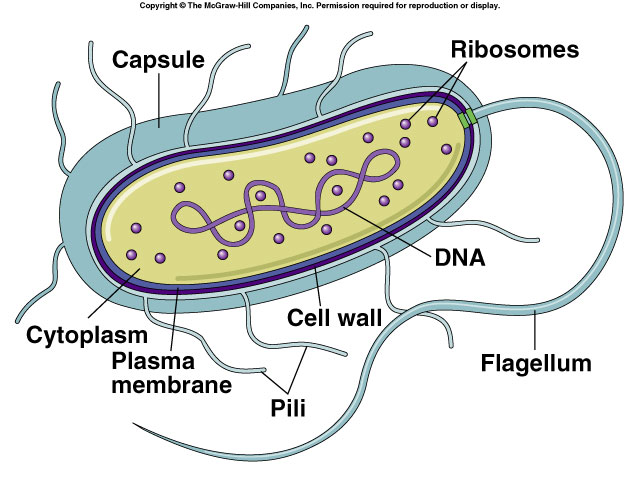
- single-celled (or sometimes chains of cells)
- very small cells
- diversity of shapes
- circular chromosomes (sometimes with extra small loops called plasmids)
- binary fission - not mitosis
- NO SEX, but....
- some can take up DNA from surroundings,
- some can transfer plasmids to other bacteria (recipient is not always the same species!)
- contain ribosomes but no membrane-bound organelles
- flagella - rotating structure, not whip-like as in Eukaryotes
- MUCH greater metabolic diversity than seen in Eukaryotes.
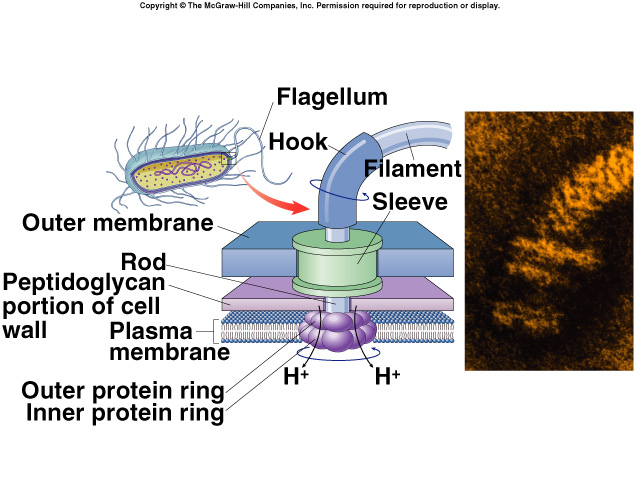
4. Some major prokaryote groups (don't worry about branching patterns and names of groups in the diagram below, but look at photos to get an appreciation for some of the diversity in form. Note that the colors are false colors added for contrast.)
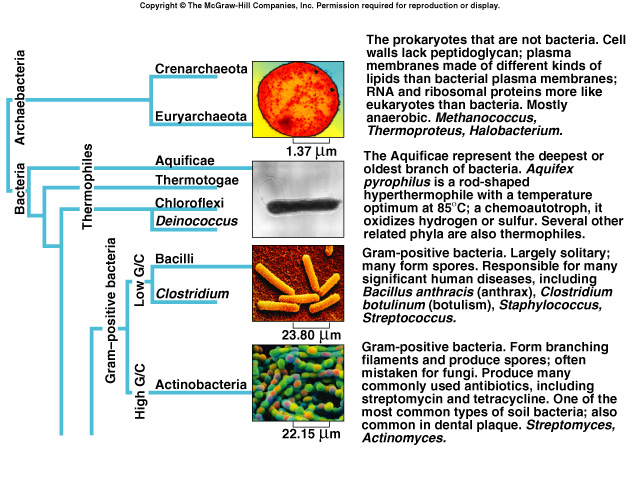 |
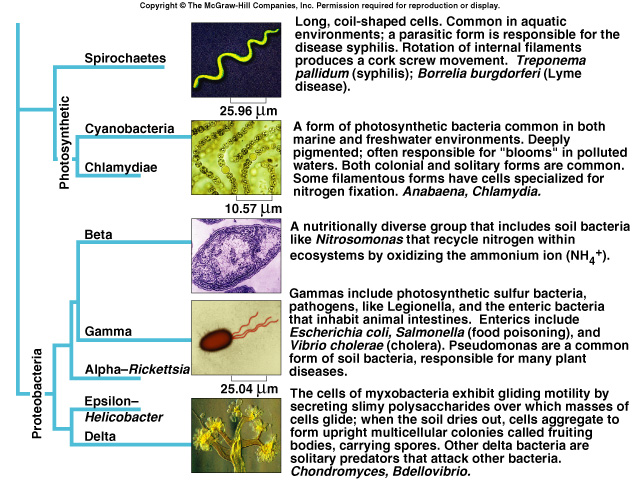 |
Gram positive bacteria take up gram stain while gram negative bacteria do not due to an extra layer in cell wall. Gram stain (and other stains that stain specific bacterial groups) is commonly used as part of the screening process to identify certain bacteria.
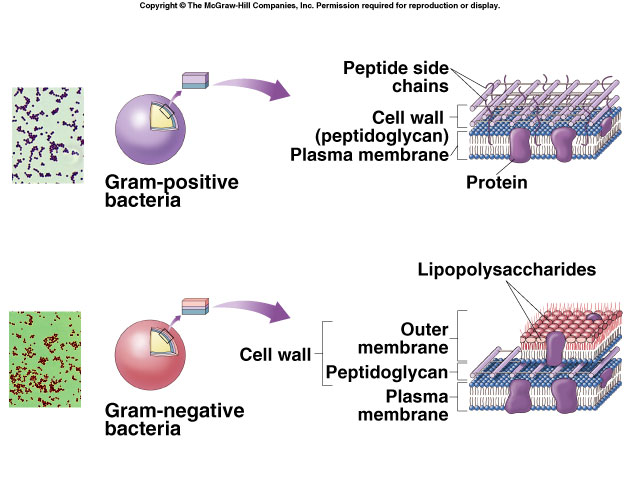
5. Prokaryotic metabolism - HUGE DIVERSITY of ways of making a living!
MUCH greater variety than among Eukaryotes
- Photoautotrophs
- Energy from sunlight, carbon from CO2
- Some do photosynthesis just like green plants:
- chlorophyll a to capture light
- H2O as electron donor
- O2 as waste product
- Others use
- bacteriochlorophyll to capture light
- H2S as electron donor
- elemental sulfur as byproduct
- Chemoautotrophs
- Energy from oxidation of inorganic substances
- Nitrifying bacteria - play central roles in nitrogen cycle
- ammonia -> nitrite
- nitrite -> nitrate
- Others oxidize sulfur, H2, or other inorganic molecules
- Some oxidize hydrogen sulfide
- some of these form the basis of food webs near hydrothermal vents deep in ocean
- Some types of chemoautotrophs are abundant in cracks and crevices in rocks deep withing the earth's crust!
- Photoheterotrophs
- Energy from light, carbon from organic compounds
- Chemoheterotrophs
- energy and carbon from organic compounds
- Examples:
- decomposers
- pathogens/parasites
- etc
- Some prokaryotes require O2 -aerobes
- Some use it if available, but can get by without it - facultative aerobes (or facultative anaerobes)
- Some cannot tolerate O2 at all!
- Use a variety of substances as terminal electron acceptors
- CO2 -> methane
- Sulfate -> hydrogen sulfide
- Iron -> more reduced forms of iron
- etc
- Some anaerobic heterotrophic bacteria are MAJOR components of biological communities in anaerobic food webs.
- sulfate reducing bacteria
- methanogens
- More than any other group of organisms, prokaryotes run the world!
- Biogeochemical cycles (nitrogen cycle, sulfur cycle, etc)
- Some parts of these cycles done ONLY by various specialized prokaryotes!
- ALL OF THESE CYCLES WERE FUNCTIONING FULLY BEFORE EUKARYOTES EVOLVED!
- Prokaryotes created the conditions of the Earth's biosphere (and play MAJOR roles in maintaining the conditions necessary for life on Earth now).
- See overview and diagram of nitrogen cycle at Wikipedia
- Basis of many marine food webs
- Prokaryotes are responsible for a very large proportion of the energy capture in oceans
- Prokaryotes are responsible for a very large proportion of O2 production globally!
- Decomposers - important for breaking down organic matter, releasing nutrients for other organisms to use.
- This nutrient regeneration is critical to the productivity of plants on land, and algae in the water.
- Nitrogen fixing bacteria make nitrogen available to plants
- N2 gas is inert
- plants (and algae) use ammonia and nitrate as sources of N
- N-fixers convert N2 to organic N (then decomposers convert organic N to ammonia)
- Cyanobacteria ("blue-green algae" - an important group of photosynthetic bacteria) - some cyanobacteria fix nitrogen
- Rhizobium - an important genus of N-fixers that live in association with roots of legumes. SEE: http://web.augsburg.edu/~capman/photoofmonth/nodules.html
- Pathogens/parasites
- Some bacteria live on or in other organsims
- Some are obligate parasites - have no other habitats or lifestyles
- Some are opportunistic
- There are many examples of commensalisms and mutualisms involving bacteria and other organisms
- internal symbionts
- fiber digesting bacteria -ruminants (MOO!) and termites
- other gut-inhabiting bacteria - there are many more prokaryotic cells in your body than human cells!
- some produce important vitamins in your colon
- most bacteria that live on or in you are harmless and even tend to protect you from pathogens by competing with them for space and resources.
- there is increasing evidence that gut bacteria can affect human health in profound ways. For example, see: http://www.bbc.com/news/magazine-35193414
- etc
- etc
- etc
- THERE ARE LOTS OF OTHER PROKARYOTE LIFESTYLES AS WELL!
(in multiple ways)